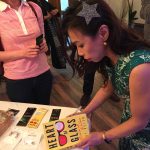The Business of Blurb
Once I found this task a chore akin to cleaning or ironing. Now I enjoy it and even do it on other people’s books. It’s the pretty and mysterious sister of the synopsis. The synopsis is a dry technical report of the book’s beats with all the spoilers but the blurb must simply look great, grab the reader and make your book bang.
What is a blurb?
A blurb is a piece of creative copywriting, 100-200 words, i.e. it’s a pitch. It’s not a synopsis because it must not have spoilers. It sets up the scene, the theme and the conflict. It is to incite reader interest only. The reader will of course include the agent and publisher.
Why should I write a blurb?
A blurb helps to engage an audience and grab them within the first 3 lines so that they will want to read the whole book. Something must be so exciting about the setting and the character that they will not be able to resist finding out what happens to the character. Character-based blurbs are more gripping than those which are just informative. Why? Humans respond to emotional conflict. We want to care. Make us care.
How do I write a blurb?
The process I am using here is distillation. Thanks to my profession in architecture and interior design for the last 25 years, I have had to come up with concepts which could be summarised and fed to clients on a spoon (or maybe just a small plate). There is no time for beating around the bush when there are budgets to cut and buildings to carve. I timed it once, and we have 17 seconds to convince someone this is a good idea. The rest of a one hour meeting is just expanding on those 17 seconds.
Here are 5 ways to do it without upsetting yourself or anyone:
- In front of a mirror, put your phone on record and ask yourself “what is your book about” as if you are a cold, hard stranger, and answer it yourself: “my book is about…” Do this as many times as you want and do it on different days so that each time you will get a few different variants. Listen to all the recordings. Take note of the timings, and what kept recurring. eg. for my new book, White Crane Strikes, “it’s about a handyman. He’s poor. He just got a great job.” etc. Keep going and don’t give up or just stick with one iteration. You are a storyteller. Tell it like it’s a story. You are pitching the story to your mirrored self (and also, the world). Once distilled, over a period of many days or weeks, you will get the essence of your real story.
- List 2-3 successful books you love and know quite well. Don’t look at the descriptions on Amazon. Write their blurbs for them. Then check on the Amazon descriptions. Did you do a good job or was it worse than the Amazon description? If it was better, why? If worse, why? What did you get right? Repeat with another 2-3 books. Once you have about 4-6 blurbs written, read through all of them and distil again.
- Take 2-3 successful books which are LIKE yours, in genre or story. Don’t say there are none. There are no new stories, my friend, only old ones with different characters and settings. Read their Amazon descriptions. Copy them. Now replace the characters and settings with yours. Rewrite it better, botox it up, massage and blend to fit your story line. In fact, forget the massage after you do it once, and just rewrite the whole thing in your own words. Those Amazon descriptions can often have clunky or poor sentence construction. Some of them are not even written by professional copywriters. Once massaged and re-written, check it to make sure it is now definitely your story! Now you have 2-3 versions of your own blurb based on 2-3 successful books.
- Practise raising 3 main points only. To do this you need to leave your manuscript unattended and on ice for a long time. Unfortunately for me it has to be months and months or even a year. This is to make sure I have forgotten most if not all of the novel except for key points. “Oh yes… let’s see… there was this guy… now what happened to him… oh yes… something did… he found something he shouldn’t have… he overheard a conversation… ah yes! That’s it!” When you have the 3 key events or points, write just those up. They form the true essence of the story. Once again, this is the process of distillation. Social distancing yourself. Finding the heart of why you spent so long writing 80,000 words takes a lot of forgetting.
- The most highly recommended way is to use an editor, at the beginning, at the middle, or at the end. At whichever point, an editor is not someone who just checks your grammar or punctuation. I can do that myself. People I trust and value for story appraisal are Holly and Maz of Marginalia Manuscripts. Without them, I would not be able to master this blurb attacking skill. Thanks to Holly and Maz, my fifth novel, based on the synopsis alone, came to be on a 12-strong longlist, the Avon x Mushens Entertainment Prize for writers from Black, Asian and minority ethnic backgrounds who are writing a commercial novel. How cool is that? An editor is a personal trainer for your writing, which, yes, although is a fine body of work, still needs to be honed, toned and lean. Don’t beat yourself up about struggling with onerous tasks. Writing the book was bad enough, right? We all need training every now and then, even those who are top at their jobs. You can download and check out Marginalia Manuscripts‘s work samples for free. You will not be disappointed.
Where can I use my blurb?
Now that you have written a brilliant blurb for fiction, you can use it on your Amazon description. You can use it for social media posts and your own blog posts. Your own copywriting is worth using and reusing. You can keep carving and massaging it to suit the purpose.
If you are having to write a synopsis, read also my post on How to Write a Synopsis for Fiction.
If you enjoyed this blog post in my The Writing Life series, please share.


